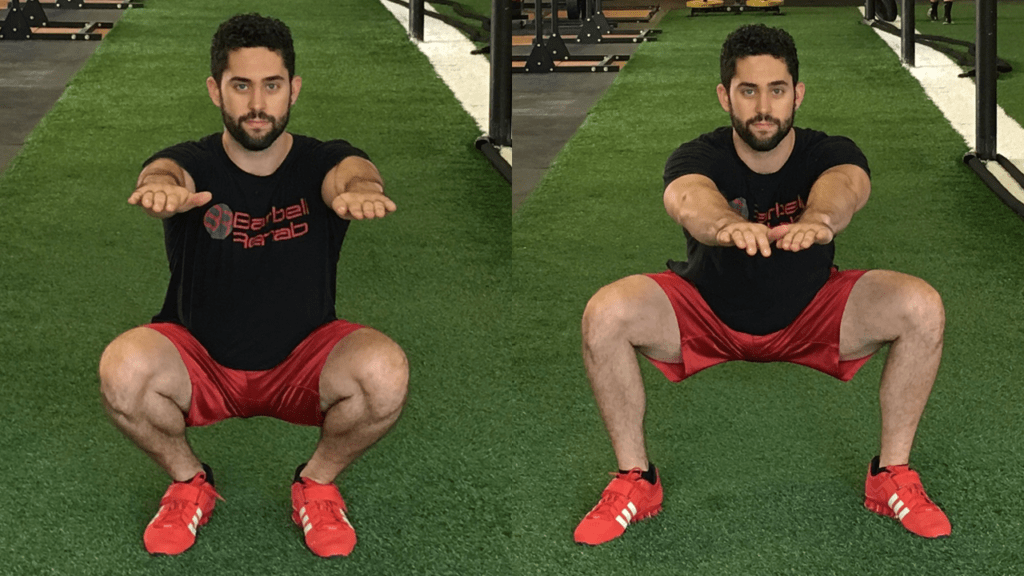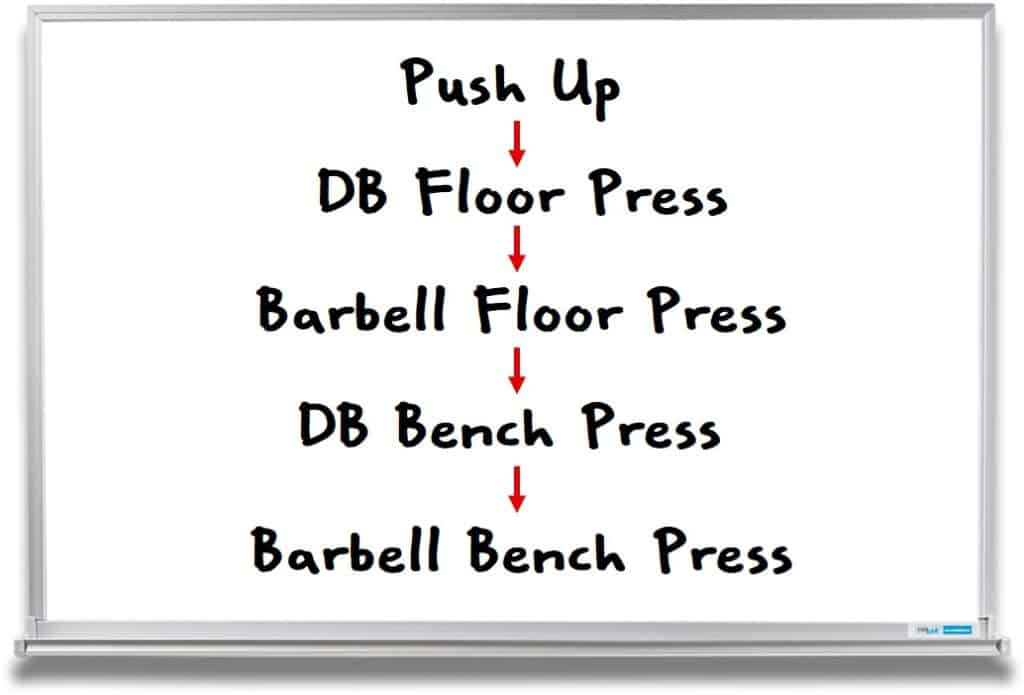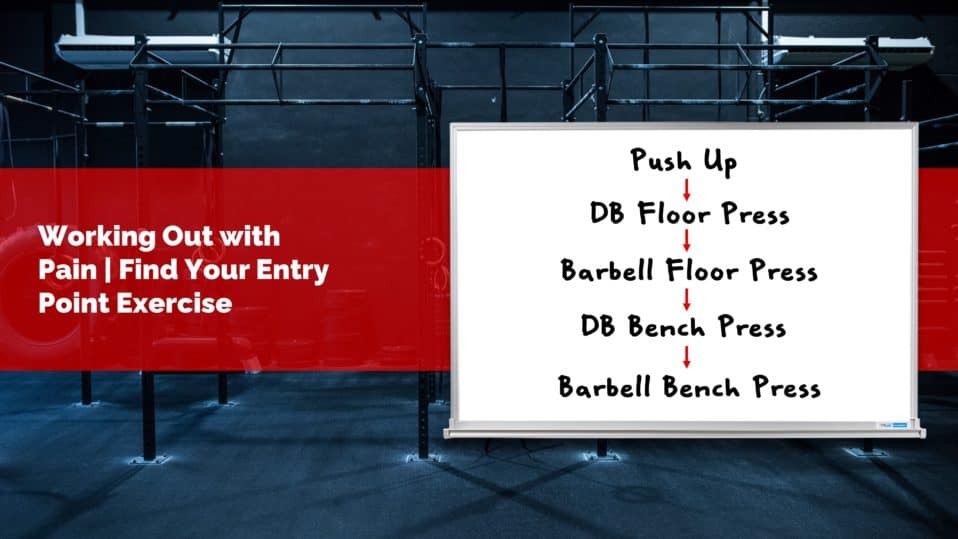Working out with pain can be a daunting task. You may have questions like: Is it ok to train through pain? Or, if an exercise hurts, what should I do? Sometimes reducing the weight or modifying the way you do an exercise isn’t enough to overcome your pain.
If this is the case, you may need to remove it all together and train a different lift. This is where the concept of finding your “entry point” exercise really comes into play.
Don’t Quit an Exercise Unless You Need To
Before you quit doing an exercise because of pain, you should first exhaust all of your options. Why? Because you don’t want to quit a painful exercise if all you need to do is change the way you do it to make it tolerable.
Whether it hurts to do a squat, bench press, deadlift, overhead press, or lunge, there are some key variables of these lifts that you should try and modify first. Here are some of the more common ones.
Modify Stance or Grip Width
Adjusting your stance on the squat or deadlift, or your grip width on the bench press or overhead press can drastically change your pain. If you’re having hip pain with squats, for example, all you may need to do is widen or narrow your stance, or turn your feet out more to immediately overcome it.

If you’re having shoulder pain on the bench press, simply moving your grip in or out can also drastically change the way it feels. As you can see, it wouldn’t make much sense to stop doing these exercises if all you needed to do was change the way you’re doing them!
Decrease Load and Slow Down the Tempo
Slowing down the lift and performing it in a more controlled manner can also drastically reduce pain. There’s a few reasons for this. First, it’s well known that tendonitis or tendinopathy issues respond really well to slow tempos. These slower tempos are what force the adaptation at the tendon level to strengthen it and reduce pain.
Furthermore, when you slow down the lift, you can stimulate a training effect with lighter loads. So if you’re dealing with pain, specifically at higher loads, try reducing the weight and slowing down the tempo. A 3:0:3 tempo is pretty standard here. To use this method, lower the weight for 3 seconds (eccentric phase), and then lift it for 3 seconds as well (concentric phase).
Programming Considerations
An often overlooked aspect when it comes to working out with pain, is programming. You can have “perfect” form and a great warm-up, but if you’re applying the stressor in a less than optimal manner, this definitely warrants attention. Here are some key programming principles I look at if someone is working out with pain:
- Are you performing too much on one day? If you’re dealing with pain during a lift and all of your volume is performed on one day, try doing LESS volume in one session, but performing 2-3 sessions per week
- Are you consistently training to failure? Contrary to popular belief, you don’t need to take all of your sets to failure. In fact, the majority of your compound lifting volume should be performed in the RPE 7.5 – 8 range. This is a sufficient stimulus to drive strength and hypertrophy, but minimize risk of injury.
For a more in-depth analysis of how to modify programming if you’re working out with pain, check out this article.
Substituting a Painful Exercise with a Tolerable Variation
Sometimes form and programming modifications don’t help reduce pain with working out. If this is the case, you may need to temporarily remove the painful exercise and substitute it with a similar variation. So, here’s the big question: What exercise should you substitute it with?
This is where the concept of the entry point really comes into play. When you need to remove a painful exercise, you should substitute it with a variation that you can perform in a tolerable fashion, that is as similar to the provocative one. That’s called the entry point.
The Entry Point Exercise Explained
Let’s use the example of shoulder pain during the bench press. Let’s say you tried changing grip width, lowering the load, and slowing down the tempo, but it still hurts. So, what’s next? You remove the bench press and substitute it with a tolerable variation. It turns out, you have a bunch of choices here, including the DB bench press, DB floor press, barbell floor press, and various push up variations. So what’s the best option?
Using the concept of the entry point, you should select a variation that is as similar to the barbell bench press as possible, that you can perform in a tolerable fashion. Let’s list the above variations in order of their similarity to the barbell bench press:

There are few variables we are dealing with here in terms of how “specific” the lift is to the barbell bench press. These include the loading method and ROM. Open chain pressing variations (dumbbell and barbells) will be more specific than closed-chain (push ups). Full ROM exercises will be more specific than partial ROM, and barbell based exercises will be more specific than push ups and dumbbell work.
Now that you know the order of specificity, let’s dig a little deeper into the concept of the entry point. If you’re having shoulder pain with the bench press but you can DB bench press in a tolerable manner, then there’s no need to regress the entire way to a push up. The entry point in this instance is the dumbbell bench press.
If, on the other hand, you can barbell floor press pain-free, then it wouldn’t make sense to do a dumbbell floor press, as the barbell will be more specific. The entry point in this example would be the barbell floor press.
This concept of the entry point works for all of the big compound lifts. If you’d like to learn more, we dig into all of this in our CEU approved online course.
How to Progress the Entry Point Exercise
Now that you know how to remove a painful exercise and substitute it with your entry point exercise, how should you progress from here? There’s a few ways you can do this. If your entry point exercise is very similar to the painful one (ex: barbell floor press instead of barbell bench press), I’d recommend training this exercise for about 4-6 weeks. Feel free to push the intensity here up to the RPE 8-8.5 range if it’s tolerable.
If, on the other hand, your entry point exercise is not very similar to the painful exercise (ex: push up instead of barbell bench press), you can slowly work up the exercise variation spectrum as tolerated until you get back to the bench press. For example, maybe you perform push ups for 2-3 weeks and then progress to a dumbbell bench press for another 2-3 weeks.
After 4-6 weeks total of training the entry point and variations, you can try re-integrating the once painful initial exercise at a light weight and see how it feels. If it feels ok, then you can work on training that again. If it still hurts, then you can keep training the variant for a few more weeks.
Stop Working Out with Pain…There’s a Better Option!
If you are tired of working out with pain and have tried modifying your form and programming, maybe it’s time to take a break from the painful exercise all together.
A few months of training a more tolerable variation of your favorite lift may be EXACTLY what you need in order to return to it stronger and more confident than ever before!

